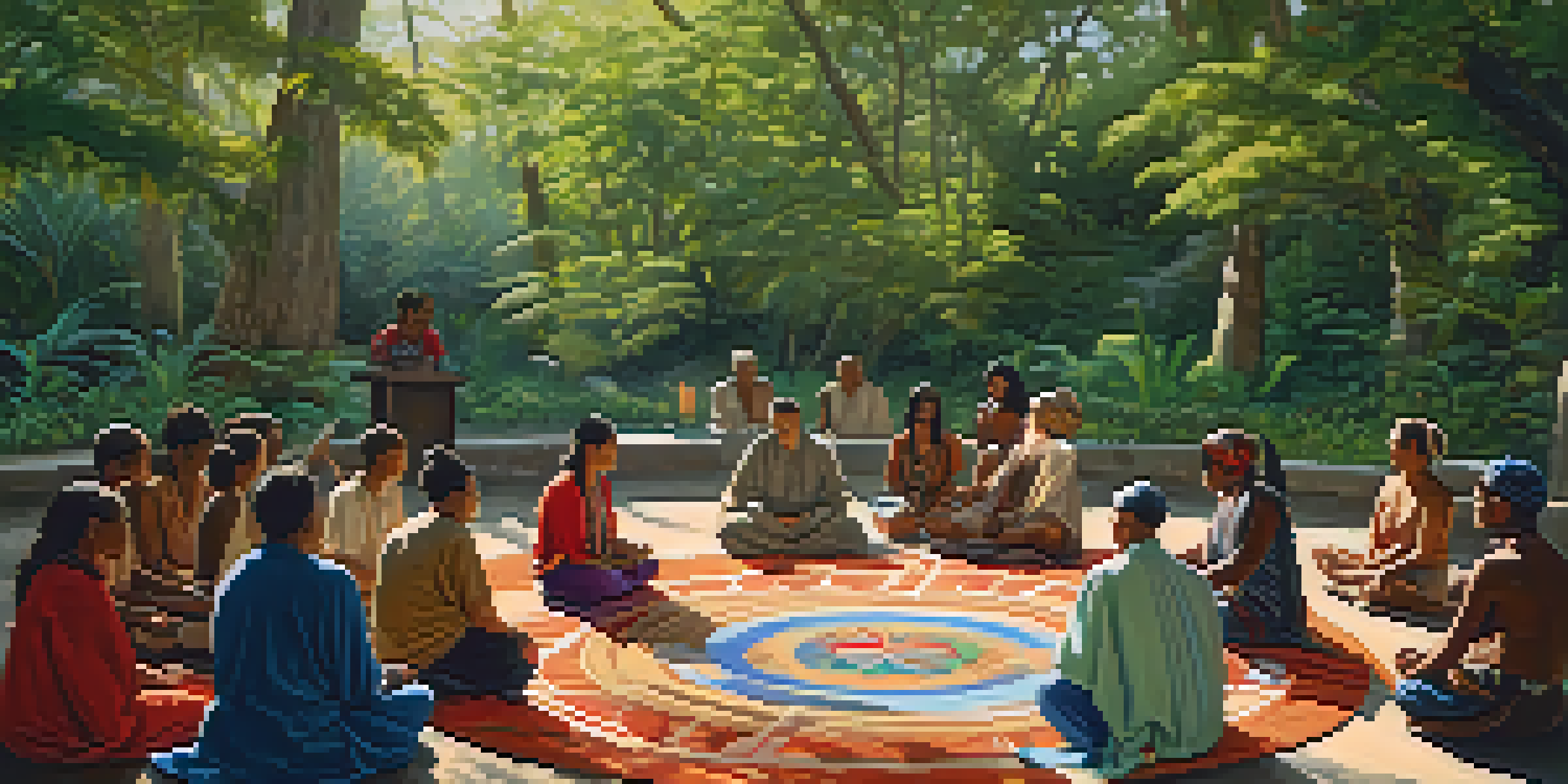Cultural Rituals: Enhancing Entheogen Experiences Globally

Understanding Entheogens: A Global Perspective
Entheogens, often derived from natural sources, are substances that induce altered states of consciousness. They have been used across many cultures for spiritual, healing, and transformative purposes. From ancient shamanic traditions to modern therapeutic settings, these substances play a vital role in the exploration of consciousness and self.
The use of entheogens is not only about experiencing altered states of consciousness but also about understanding the deeper connections to our culture and spirituality.
Different cultures have unique approaches to using entheogens, often integrating them into their rituals and practices. For example, indigenous tribes in the Amazon utilize ayahuasca for spiritual guidance, while in some Asian traditions, psilocybin mushrooms are used to enhance meditation practices. These varied applications highlight the rich tapestry of human experience and the quest for deeper understanding.
Understanding the global perspective on entheogens allows us to appreciate their significance beyond mere recreational use. By acknowledging their historical and cultural contexts, we can foster respect and appreciation for the diverse practices that enhance our experience with these powerful substances.
The Role of Rituals in Entheogen Use
Rituals serve as structured frameworks that enhance the experience of using entheogens. They provide a sense of safety and intention, guiding participants through their journey. Whether it’s a traditional ceremony led by a shaman or a modern retreat focused on mindfulness, rituals create a supportive environment for exploration.

One of the key elements of rituals is the setting, which can profoundly influence the experience. For instance, a serene natural environment can promote tranquility, while group dynamics can foster shared understanding and connection. This careful curation of space and community is essential for maximizing the benefits of entheogenic experiences.
Entheogens and Cultural Significance
Entheogens have deep historical and cultural roots, serving various spiritual and healing purposes across different societies.
Moreover, rituals often incorporate music, art, and movement, further enriching the experience. These elements not only enhance emotional resonance but also help individuals process their experiences in a holistic manner. By engaging multiple senses, rituals can transform a solitary journey into a shared exploration of consciousness.
Cultural Variations in Entheogen Rituals
Across the globe, cultures have developed distinct rituals surrounding entheogen use. For example, the Native American Church incorporates peyote into their ceremonies, emphasizing community and spirituality. In contrast, the Mazatec people of Mexico engage in mushroom ceremonies that focus on personal healing and introspection.
Rituals provide a safe container for exploration, allowing individuals to navigate their experiences with intention and support.
These variations reflect the diverse ways societies interpret and integrate entheogens into their spiritual practices. Each culture imparts its unique beliefs, values, and traditions, influencing how individuals engage with these substances. This cultural richness contributes to a broader understanding of human connection with the natural world.
Recognizing these cultural differences is crucial for fostering respectful and responsible use of entheogens. As more people seek these experiences, it is essential to honor the traditions that have shaped their use over centuries. This respect not only preserves cultural heritage but also enhances our own experiences.
Psychological Benefits of Ritualized Entheogen Use
Ritualized use of entheogens can lead to significant psychological benefits, including increased emotional resilience and improved mental health. The structured nature of rituals helps participants navigate their experiences, often leading to profound insights and personal growth. For many, these journeys can catalyze healing from trauma and foster a greater sense of self-awareness.
Studies have shown that participants in structured entheogen ceremonies report lower levels of anxiety and depression. The communal aspect of rituals can also alleviate feelings of isolation, providing a sense of belonging and support. This combination of personal and communal healing is a powerful aspect of the entheogen experience.
Rituals Enhance Entheogen Experiences
Structured rituals provide a safe and intentional framework that enriches the entheogenic experience, fostering community and personal insight.
Additionally, the insights gained during these rituals can lead to lasting changes in perspective and behavior. Many individuals find that their experiences encourage them to adopt healthier lifestyles or deepen their spiritual practices. This transformative potential highlights the importance of integrating psychological support into the entheogen experience.
Modern Adaptations of Traditional Rituals
As interest in entheogens grows, many modern adaptations of traditional rituals are emerging. These new practices often blend ancient traditions with contemporary wellness philosophies, making them accessible to a wider audience. For example, some retreats now offer guided journeys that incorporate elements of mindfulness and psychotherapy.
These adaptations aim to honor the original cultural practices while addressing the needs of modern participants. By maintaining a focus on intention, community, and safety, these modern rituals strive to create meaningful experiences. This evolution reflects a broader trend of integrating ancient wisdom into contemporary life.
However, it’s essential to approach these adaptations with sensitivity and respect. Understanding the origins of these practices can help prevent cultural appropriation and ensure that the spirit of the original rituals is preserved. This commitment to authenticity enriches both the modern experience and the cultural heritage of entheogens.
Legal and Ethical Considerations in Ritual Use
The legal landscape surrounding entheogens varies significantly across the globe, impacting how rituals are conducted. In some places, certain substances are protected under religious freedom laws, allowing indigenous practices to thrive. In contrast, in many countries, strict regulations hinder access and participation in traditional rituals.
Ethical considerations also play a crucial role in the conversation around entheogen use. It’s essential to ensure that participants are fully informed and consenting, particularly in modern settings that adapt traditional practices. This emphasis on ethics helps to create a safe and respectful environment for all involved.
Future of Entheogens and Science
The integration of traditional rituals with modern scientific research may lead to more effective therapeutic applications of entheogens.
Furthermore, as the popularity of entheogens grows, it’s vital to advocate for responsible use. Promoting awareness of the cultural origins and the importance of preserving these rituals can help foster a more respectful relationship with these powerful substances. This approach not only benefits individuals but also honors the communities that have historically utilized them.
Future Directions: Integrating Rituals and Science
The future of entheogen use lies at the intersection of traditional rituals and modern scientific research. As studies continue to explore the therapeutic benefits of these substances, there’s a growing recognition of the importance of cultural context. Researchers are increasingly considering how rituals can enhance the efficacy of entheogens in clinical settings.
Integrating traditional practices into modern therapy could lead to more holistic approaches to mental health. By combining the insights of indigenous wisdom with scientific rigor, we can create frameworks that respect cultural heritage while addressing contemporary challenges. This collaboration may pave the way for innovative treatment modalities.

Ultimately, the ongoing dialogue between cultures and science can enrich our understanding of entheogens. As we move forward, prioritizing respect, ethics, and community engagement will be crucial. This balanced approach can enhance the benefits of entheogens while honoring the traditions that have shaped their use for generations.